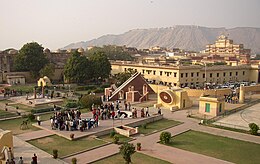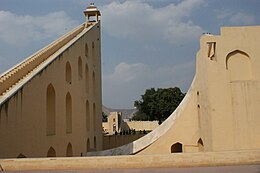| Jantar Mantar | |
|---|---|
 | |
| Location | Jaipur, Rajasthan, India |
| Coordinates | 26°55′29″N 75°49′28″E / 26.92472°N 75.82444°E |
| Area | 1.8652 ha (4.609 acres) |
| Built | 1728–1734 |
| Governing body | Government of Rajasthan |
| Official name | The Jantar Mantar, Jaipur |
| Criteria | Cultural: (iii), (iv) |
| Designated | 2010 (34th session) |
| Reference no. | 1338 |
| Region | Southern Asia |

The Jantar Mantar is a collection of 19 astronomical instruments built by the Rajput king Sawai Jai Singh, the founder of Jaipur, Rajasthan. The monument was completed in 1734.[1][2] It features the world's largest stone sundial, and is a UNESCO World Heritage Site.[1][3] It is near City Palace and Hawa Mahal.[4] The instruments allow the observation of astronomical positions with the naked eye.[1] The observatory is an example of the Ptolemaic positional astronomy which was shared by many civilizations.[1][2]
The monument features instruments operating in each of the three main classical celestial coordinate systems: the horizon-zenith local system, the equatorial system, and the ecliptic system.[2] The Kanmala Yantraprakara is one that works in two systems and allows transformation of the coordinates directly from one system to the other.[5] It has the biggest sundial in the world.
The monument was damaged in the 19th century. Early restoration work was undertaken under the supervision of Major Arthur Garrett, a keen amateur astronomer, during his appointment as Assistant State Engineer for the Jaipur District.[6]
- ^ a b c d "The Jantar Mantar, Jaipur - UNESCO World Heritage Centre". Whc.unesco.org. 31 July 2010. Retrieved 11 November 2012.
- ^ a b c The Jantar Mantar at Jaipur, India Archived 22 June 2020 at the Wayback Machine Portal to the Heritage of Astronomy, in partnership with UNESCO World Heritage Site
- ^ Smithsonian. Timelines of Science. Penguin. p. 136. ISBN 978-1465414342.
- ^ Yukio Ohashi (Editor: H Selin) (1997). Encyclopaedia of the History of Science, Technology, and Medicine. Springer. pp. 83–86. ISBN 978-0792340669.
{{cite book}}:|last1=has generic name (help) - ^ Sharma, VN (1991). "The Kapala Yantras of Sawai Jai Singh" (PDF). Indian Journal of History of Science. 26 (2): 209–216. Archived from the original (PDF) on 5 May 2015.
- ^ Monthly Notices of the Royal Astronomical Society, Vol. 81, p. 257


